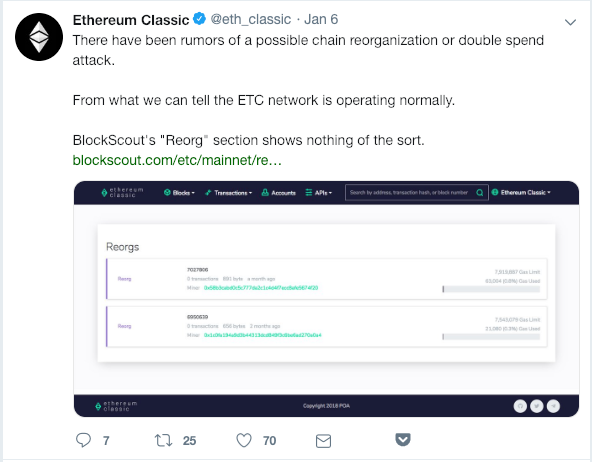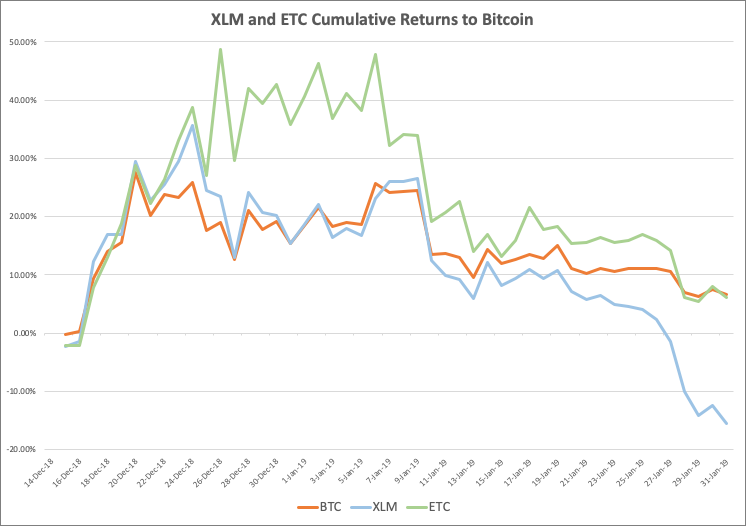
Varying levels of transparency exist with some companies burying their progress within Github and others providing hourly updates on Twitter. Below we look at four projects that during the month of January outperformed or underperformed the broader market* based on their level of transparency.
*Bitcoin is used as a the “broader market” benchmark in our calculations.
During the end of last year, the Ethereum community was abuzz with the unveiling of Ethereum 2.0, the Ethereum Foundation’s roadmap to ultimately scale the network over the next two years. The first part of this upgrade, called Constantinople, was to be implemented during a hard fork on January 16. The upgrade had technically already been delayed once.
(it was originally planned for last November) and the community was eagerly holding their breath to see if the upgrade would be pulled off. For several weeks, the impending hard fork was discussed on every medium imaginable: Twitter, Medium, large crypto outlets and more. Almost everyone in crypto was confident that the update would be pulled off with little to no hiccups.
Then came the wrench: on the morning of January 15, a little-known security firm, Chainanalysis, published a report that exposed a reentrancy vulnerability in the Constantinople code. This security vulnerability could only be exposed in specific instances and most smart contracts would not be susceptible to the reentrancy attacks.
The market reacted immediately to the news, dropping ETH by 6%. Within a few hours however, the Ethereum development team had announced on Twitter and their blog that they had decided to delay the upgrade until the security flaw could be patched. What was impressive about the response was the Ethereum Core Developers’ openness and speed with which they addressed the issue and came to a consensus on next steps. Despite the instant price drop, the market rewarded the transparency, and the price of ETH rallied back to end the week largely unchanged. It’s only during crises and high stress situations like these that projects and teams are tested.
In similar fashion, Tron spent the month of January delivering on deadlines for software updates, dapp platforms and announcing the tokenization of the BitTorrent platform. While many criticize Tron’s CEO and Founder, Justin Sun, for his marketing tactics and his frequent Twitter updates, the project can’t be faulted for a lack of communication and transparency with their community. The price of TRX mirrored the positive community sentiment, outperforming the broader market, and ending the month of January up 37%.
The Stellar Foundation has proved this by not delivering any kind of material update for the last three months, massively driving down the price of Lumens (XLM). As other tokens, like Bitcoin, recovered 6% from the November and December market lows (11/15–12/14/18), Stellar has continued to sell off and is down over 15% since mid December.
These foundations are not companies and are not beholden to token holders to provide updates or boost confidence, but the market has spoken about how they feel in regards to the lack of transparency from the foundation. It’s not like Stellar has nothing to update the community about either. Specifically, the foundation has not yet provided material updates regarding the launch of their Lightning network, Starlight or the Blockchain.com XLM airdrop, both of which happened in late 2018. Although community updates have been provided via their blog and mailing lists, these updates did not touch or identify real progress on these high profile initiatives. Without tangible updates from the foundation, the community can only assume the worst: the lightning network has seen very little usage and only a small percentage of the airdrop was claimed, translating to low adoption of the Stellar network and Lumens.
On January 5, Coinbase detected a “deep chain reorganization” prompting them to stop transactions with the Ethereum Classic blockchain. As rumors circulated that ETC was potentially suffering from a 51 percent attack, the Ethereum Classic developers tweeted out a statement that they did not believe an attack was ongoing or that there were issues.

Hours later their account warned major exchanges to increase confirmation times in order to catch any doublespend activity, yet made no admission of an attack. Over the next two days it came to light through a report from security firm SlowMist and an official blog post from Coinbase, that a 51 percent attack had occurred. By the time Ethereum Classic began to acknowledge the attack, $1.1m in funds had already been stolen. Finally, on January 9, a post-mortem was published following a community ETC meeting.
While the 51 percent attack on ETC was very different from ETH’s last minute suspension of its hard fork, the two events bring to light the importance of speed and communication in reacting to crises. While ETC was slow to respond and act, ETH was faster on the trigger, acting out of an “abundance of caution”. ETC’s messaging was mixed and ambiguous, while ETH’s was clear and direct. ETC’s price for the remainder of January has mirrored the market’s sentiment on its handling of the attack. After staying apace with the overall market’s recovery from mid December last year, ETC price has steadily declined 21% in value since the attack came to light.

Leaders in the crypto space (and any business for that matter) have to understand that they are responsible and have an obligation to their community. Communities are the powerhouse of these tokens whether we like it or not. Transparency is a theme not just present in crypto, but across most of the business sector, as a new generation of consumers with greater access to information has come into purchasing power. Transparency has become of the utmost importance not just because information should be accessible but because it promotes fairness. In an ecosystem whose ethos is decentralization, redistribution of power and wealth, this fairness is the key to success.
— The Arca Research Team
Follow us:
Medium Katie Talati & Hassan Bassiri
Twitter at @KatieTalati @HassanBassiri @Arca
Disclaimer: This commentary is provided as general information only and is in no way intended as investment advice, investment research, legal advice, tax advice, a research report, or a recommendation. Any decision to invest or take any other action with respect to any investments discussed in this commentary may involve risks not discussed, and therefore, such decisions should not be based solely on the information contained in this document. Please consult your own financial/legal/tax professional.
Statements in this communication may include forward-looking information and/or may be based on various assumptions. The forward-looking statements and other views or opinions expressed are those of the author, and are made as of the date of this publication. Actual future results or occurrences may differ significantly from those anticipated and there is no guarantee that any particular outcome will come to pass. The statements made herein are subject to change at any time. Arca disclaims any obligation to update or revise any statements or views expressed herein. Past performance is not a guarantee of future results and there can be no assurance that any future results will be realized. Some or all of the information provided herein may be or be based on statements of opinion. In addition, certain information provided herein may be based on third-party sources, which is believed to be accurate, but has not been independently verified. Arca and/or certain of its affiliates and/or clients may now, or in the future, hold a financial interest in investments that are the same as or substantially similar to the investments discussed in this commentary. No claims are made as to the profitability of such financial interests, now, in the past or in the future and Arca and/or its clients may sell such financial interests at any time. The information provided herein is not intended to be, nor should it be construed as an offer to sell or a solicitation of any offer to buy any securities, or a solicitation to provide investment advisory services.
These Stories on Investing Themes